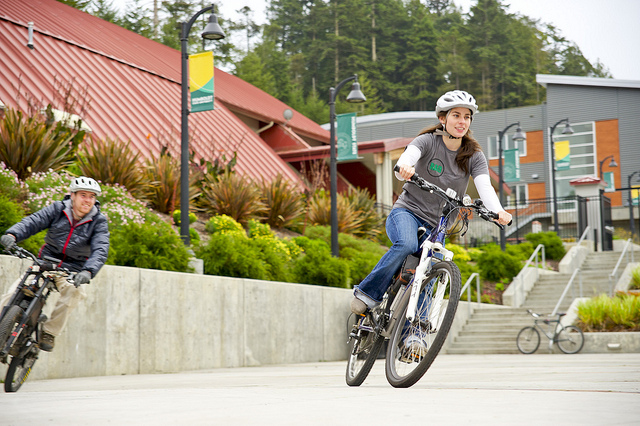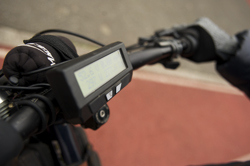
“I’d be so hot and sweaty by the time I got to school that I’d need an extra ten minutes just to cool down,” she recalls.
White-Espin’s daily commute got a lot easier a few months ago when she asked a friend to attach a lithium-ion battery to her Kona brand bike, making the vehicle electric-powered.
The battery means she can alternate regular pedaling with a power-assisted boost when she needs an extra lift. The technology has made her life a lot easier and cut her 15-minute trip in half, she says.
White-Espin is one of growing number of Humboldt State students, faculty and staff using electric-powered bikes get to work, class and run day-to-day errands. The silent, rechargeable bikes have become popular in recent years as commuters around the world turn to cheaper, more energy-efficient ways to get around.
Mike Conway (’12), a graduate student in HSU’s Environment and Community Program, serves on the board of Green Wheels, an Arcata non-profit that promotes alternatives to driving. He says that electric bikes are popular among people looking for physical assistance, a way to save money and reduce their carbon footprint.
“The economic, environmental and health benefits of riding an electric bike are definitely better than driving a car,” Conway says. Compared to a car, riding an electric bike can translate into significant cost savings. At today’s gas prices, an 8-mile trip with a car that gets 20 miles to the gallon could cost around $1.50. The same trip with an electric bike would cost 5 cents.

Electric bikes are powered through a rechargeable battery attached to the bike. The battery is activated through an on-off switch and the motor starts by turning the handlebar throttle. When the bike is idling or coasting downhill, the battery automatically charges. Depending on the battery type, a full charge lasts between 15 and 40 miles. Most have a shelf life of between 500 and 1,000 charges. A typical conversion costs between $1,000 and $2,000 and can include a digital screen that displays battery voltage and energy use.
Mike Radenbaugh (’12, Industrial Technology) estimates that he’s built around 50 electric bikes since starting his company, Rad Power Electric Bikes in 2007. A native of southern Humboldt, Radenbaugh grew up in an energy-conscious family and played with electric engines as a kid. He had a chance to hone his expertise by majoring in industrial technology at HSU, which includes classes in design and electronics. Radenbaugh says that a quarter of his customers have been HSU students, faculty and staff looking for an alternative to biking and driving.
HSU Art Lecturer Mimi Dojka says she used to battle headwinds when pedaling from campus to her McKinleyville home. Since converting her mountain bike to an electric bike last year, however, she has shaved 15 minutes off her commute.
“Not only does the motor allow me to carry more weight while I’m riding, it’s definitely an attractive option given the parking situation on campus,” Dojka says.
In larger cities, some companies are turning to electric bikes to conduct business. SoupCycle in Portland uses electric-assist bikes to make soup deliveries and B-Line Delivery relies on electric cargo tricycles instead of trucks and vans to make businesses deliveries. Electric bikes have been around for years in densely populated China and are starting to outnumber cars in some cities, according to news reports.
White-Espin says she sometimes startles motorists when riding her soundless electric bike in Arcata.
“I probably get the weirdest looks when I come to stop signs,” she says. “They’ll look over, roll down their window and be like what is that?” White-Espin says. “And I just tell them, it’s an electric bike.”